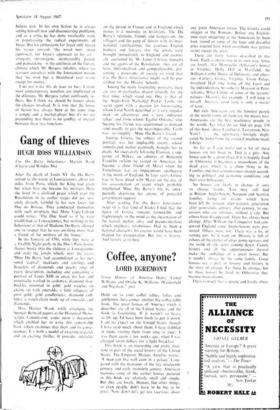Gang of thieves HUGH ROSS WILLIAMSON
i he Da Bari y Inherimm•e Marion Ward What to and Windus 30s)- After the death of Louis X\" the Du Barry retired to the estate at Louveciennes, about ten miles from Paris, which the King had giYen her when first she became his mistress. Here she lived in a civilised peace which. even the Revolution in its earlier stages did no; seri- ously disturb, faithful to her new lover, the Duc de Brissac. They conducted themselves with such propriety that Mme Vigec-Lebrun could write: 'The Due lived as if he were established at Louveciennes, but nothing in his behaviour or that of Madame Du Barry allowed one to suspect that he was anything more than a friend of the mistress of the house.'
In the January of 1791, while they were at a Twelfth Night party in the Duc's Paris house. thieves broke into the château at Louveciennes and stole the jewels which, over the years. Mme Du Barry had accumulated as her per- sonal `capital'- --necklaces and earrings and bracelets of diamonds and pearls; rings of every description, including one containing a -portrait of Louis XIII in onyx, his hair and moustache worked in sardonyx: diamond shoe- buckles mounted in gold: gold watches on chains set with emeralds; a little reliquary, of pure gold; gold candlesticks; diamond cuff- links; a watch-chain made up of emeralds and diamonds.
Miss Marion Ward, while arranging the Spencer Bernard papers at the Historical Manu- scripts Commission, came upon a document which enabled her to write this remarkable hook which examines that theft and its conse- quences. It is both a model of exacting research and an exciting thriller. It provides sideligbis
on the period in France and in England which makes it a necessity to historians. The Du Barry's relations, friends and hangers-on, the villagers and the gang of thieves with its inter- national ramifications, the cautious English bankers and lawyers (for the jewels were brought immediately- to England and eYentu- ally auctioned by Mr James Christie himself) and the agents of the Revolution- they are all here. individualised and comprehensible, pre- senting a panorama of society so vivid that he MI Barry Inheritance might well he pre- scribed for the History Schools.
Among the many fascinating portraits, there are two in particular. drawn virtually for the first lime. which stand out. One is that of the Anglo-Irish Nathaniel Parker Forth. the secret agent with a passion for horse-racing. whom Lord North described as 'a y Cr} singular man. an adventurer and a very indiscreet talker and from whom 'Egalite Orleans,' who became his friend, was accustomed to demand land usually to get) the near-impossible. Forth was to simplify --Mme Du Barry's friend.
George Grieve, the subject of the second portrait. was her implacable enemy, whose unmotivated malice eventually brought her to death. An excessively left-wing Etonian, a sup- porter of Wilkes, an admirer of Benjamin Franklin w horn he visited in America). he became a close friend of Marat when the Frenchman was an impecunious apothecary in the north of England. In later years. Grieve was to have dined with Marat on the day of his assassination -an event which probably lengthened Mme Du Barry's life by unex- pectedly depriving her enemy of powerful government support.
After reading The Du Barry Inheritance twice (it is that kind of book), I find that the figure of Grieve remains formidably and frighteningly: in the mind as the incarnation of the hatred, malice, envy and pseudo-idealism which engineers revolutions. Had he been a fictional character, his creator would have been blamed for exaggeration. But this is history. And history at its best:*






























 Previous page
Previous page